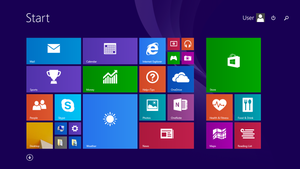| Version of the Windows NT operating system | |
 Default Windows 8.1 start screen | |
| Developer | Microsoft |
|---|---|
| OS family | Microsoft Windows |
| Source model | |
| Released to manufacturing | August 27, 2013[1] |
| General availability | October 17, 2013[2] |
| Final release | 6.3.9600 with January 10, 2023 update rollup / January 10, 2023[3][4] |
| Marketing target | Consumer and business |
| Update method | Windows Update, Windows Store, Windows Server Update Services |
| Platforms | IA-32, x86-64 |
| Kernel type | Hybrid |
| Userland | Windows API, NTVDM |
| License | Trialware, Microsoft Software Assurance, MSDN subscription, Microsoft Imagine |
| Preceded by | Windows 8 (2012) |
| Succeeded by | Windows 10 (2015) |
| Official website | Windows 8.1 (archived at Wayback Machine) |
| Support status | |
All editions except Windows Embedded 8.1 Industry:
Windows Embedded 8.1 Industry: | |
| Part of a series of articles on |
| Windows 8 |
|---|
| Siblings |
| Related |
Windows 8.1 is a release of the Windows NT operating system developed by Microsoft. It was released to manufacturing on August 27, 2013, and broadly released for retail sale on October 17, 2013, about a year after the retail release of its predecessor, and succeeded by Windows 10 on July 29, 2015. Windows 8.1 was made available for download via MSDN and Technet and available as a free upgrade for retail copies of Windows 8 and Windows RT users via the Windows Store. A server version, Windows Server 2012 R2, was released on October 18, 2013.
Windows 8.1 aimed to address complaints of Windows 8 users and reviewers on launch. Enhancements include an improved Start screen, additional snap views, additional bundled apps, tighter OneDrive (formerly SkyDrive) integration, Internet Explorer 11 (IE11), a Bing-powered unified search system, restoration of a visible Start button on the taskbar, and the ability to restore the previous behavior of opening the user's desktop on login instead of the Start screen.
Windows 8.1 also added support for then emerging technologies like high-resolution displays, 3D printing, Wi-Fi Direct, and Miracast streaming, as well as the ReFS file system.[8]
Windows 8.1 received more positive reception than Windows 8, with people appreciating the expanded functionality available to apps in comparison to Windows 8, its OneDrive integration, its user interface tweaks, and the addition of expanded tutorials for operating the Windows 8 interface. Despite these improvements, Windows 8.1 was still criticized for not addressing all issues of Windows 8 (such as poor integration between Metro-style apps and the desktop interface), and the potential privacy implications of the expanded use of online services. Windows 8.1 would be succeeded by Windows 10 in 2015.
Mainstream support for Windows 8.1 ended on January 9, 2018, and extended support ended on January 10, 2023.[9] Mainstream support for the Embedded Industry edition of Windows 8.1 ended on July 10, 2018, and extended support ended on July 11, 2023.
- ^ Bott, Ed (August 28, 2013). "Why is Microsoft keeping the final release of Windows 8.1 secret?". ZDNet. CBS Interactive. Archived from the original on March 7, 2018. Retrieved January 18, 2017.
- ^ LeBlanc, Brandon (October 17, 2013). "Windows 8.1 now available!". Windows Experience Blog. Microsoft. Archived from the original on November 3, 2019. Retrieved January 18, 2017.
- ^ "Why I love today's Windows 8.1 Update". Windows Experience Blog. April 8, 2014. Archived from the original on December 22, 2019. Retrieved December 22, 2019.
- ^ "January 10, 2023—KB5022352 (Monthly Rollup)". support.microsoft.com. January 10, 2023.
- ^ "Windows 8.1 has reached end of service". Microsoft Documentation. January 10, 2023. Archived from the original on January 12, 2023. Retrieved January 13, 2023.
- ^ "Microsoft Support Lifecycle, Windows 8". Microsoft. Archived from the original on January 3, 2024. Retrieved January 21, 2023.
- ^ a b "Product lifecycle Windows 8.1 Industry". support.microsoft.com. Retrieved August 21, 2020.
- ^ "Resilient File System Overview". technet.microsoft.com. January 13, 2017. Archived from the original on September 1, 2017. Retrieved January 6, 2017.
- ^ "Windows 8.1 support will end on January 10, 2023". support.microsoft.com. Archived from the original on June 24, 2022. Retrieved June 24, 2022.